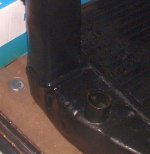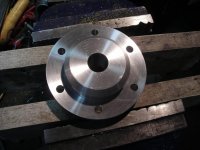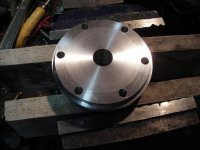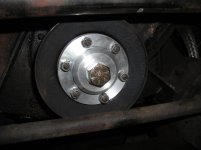Geo brings up some good points. I first converted to an electric fan on a previous TR3A many years ago because I was looking for a bit more power (and because my mechanical fan was ruined with no obvious replacement readily available. Things are different now.). More recently, I found that the mechanical fan on the TR3 just wasn't quite enough when doing extended stop-and-go traffic in high ambient temps. Although I try to avoid such things, it's not terribly uncommon for me to have to spend an hour or more doing no more than 10-15 mph with ambient well over 90F.
To get back to your questions, the puller configuration does seem to work better. 'Pusher' will work, but the fan seems to upset and limit air flow at higher speeds. When i installed one on my Stag (as a temporary replacement for the broken mechanical fan), it actually caused the engine to run noticeably hotter at freeway speeds, whether the fan was powered or not.
There is a big bolt that runs through the fan extension and clamps the extension, pulley and hub assembly to the front of the crankshaft. You have to keep some sort of pulley obviously, for the belt that turns the water pump and generator. However, with the extension removed, a shorter bolt and large flat washer may pull up against the end of the crankshaft and fail to clamp the hub firmly enough. Over time, the hub works back and forth against the key, eventually tearing up both of them. BTDT
I think it was Rick Patten who offers a nicely made blanking plate and bolt to solve this problem; but what I use is basically a hollow cap that fits over the end of the crankshaft, and clamps the original hub firmly. Lacking much in the way of machine tools at the time, it was made from a cast iron pipe cap, which I drilled for a center bolt and then spun in the drill press to file down the outside to fit into the hub.
The original metal fan was mounted on rubber bushings, which some believe acted to dampen some harmonic resonances in the crankshaft. At least in theory, operation at one of the resonant frequencies (rpm) causes extra stress in the crank, which can lead to a broken crankshaft. Hence the replacement pulleys with integral harmonic dampener.
But I suspect this applies mostly to racing TRs, where operation at full throttle above 5000 rpm is the rule, and the engines have been modified to produce considerably more power than stock (both of which add greatly to stress within the crankshaft). At any rate, I've driven probably over 200,000 miles with no damper and no crankshaft problems.
Another issue to consider is where the power for the fan is coming from. My current TR3 is still wearing its stock 19 amp generator, and it will not keep up with both headlights and fan. Fortunately I have a fan controller that only runs the fan for a few seconds at a time (until the water coming back from the radiator drops below 190F) so I've been getting by OK for the past couple of years. If the generator dies though, I plan to install a 'mini' alternator that puts out about 40 amps.

 Hey there Guest!
Hey there Guest!
 smilie in place of the real @
smilie in place of the real @
 Pretty Please - add it to our Events forum(s) and add to the calendar! >>
Pretty Please - add it to our Events forum(s) and add to the calendar! >> 




 A friendly reminder - be careful what links you click on here. If a link is posted by someone you don't know, or the URL looks fishy, DON'T CLICK. Spammers sometimes post links that lead to sites that can infect your computer, so be mindful what you click.
A friendly reminder - be careful what links you click on here. If a link is posted by someone you don't know, or the URL looks fishy, DON'T CLICK. Spammers sometimes post links that lead to sites that can infect your computer, so be mindful what you click.